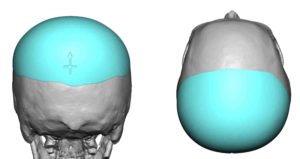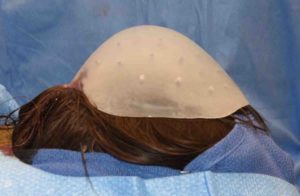Background: A flat back of head is one of the most common aesthetic skull problems that is treated. It is best augmented with a custom skull implant made from the patient’s 3D CT scan. This lessens dramatically the aesthetic risks of implant irregularities and edge transitions as well as asymmetry of the contours of the augmentation. There is a huge advantage to controlling the shape and thickness of the implant before surgery. This then leaves the role of the surgeon during surgery to ‘merely’ position it on the skull as it was designed.
The other major benefit to a custom implant that is flexible is that it can be inserted through a smaller scalp incision than that of the diameter of the implant. Every cm of scalp incision (or less thereof) can be of valuable aesthetic consequence. This also speaks to the value of a preformed implant whose shape and thickness can not be altered by the insertion process.
While a smaller scalp incision is of aesthetic benefit, it also severely limits a view of the implant’s position on the skull bone. Not seeing the circumference of the implant’s position on the skull bone can potentially create implant malposition. A curved implant on a curved bone surface under the compression of the overlying scalp can make it seem that just about any implant position is correct.


Most custom skull implants benefit in positioning with an embossed compass marker, regardless of what skull area they cover. The limited view of the implant with discrete scalp incisions requires visible registrations to aid in its orientation.
Highlights:
- A custom occipital skull implant is the most effective way to build up a flat back of the head.
- Proper positioning of a skull implant in which the scalp incision. permits limited visibility requires a registration mark on the exposed part of the implant.
- A compass marker provides a 3D orientation method for skull implant positioning.
Dr. Barry Eppley
Indianapolis, Indiana



